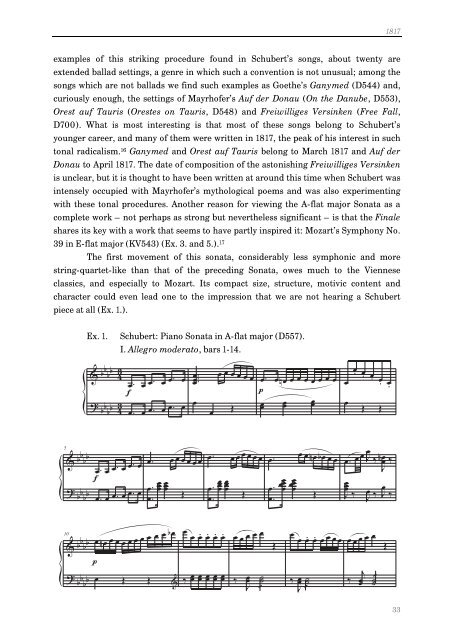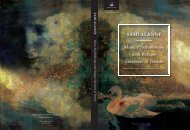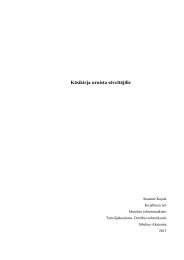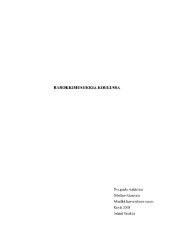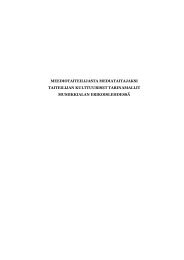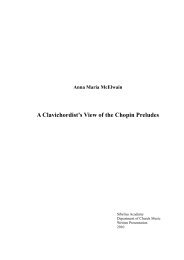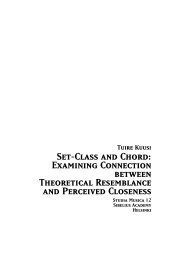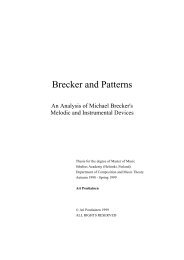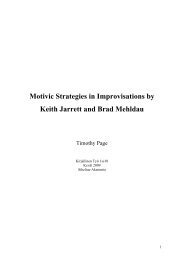The Unfinished Piano Sonatas of Franz Schubert Javier ... - Ethesis
The Unfinished Piano Sonatas of Franz Schubert Javier ... - Ethesis
The Unfinished Piano Sonatas of Franz Schubert Javier ... - Ethesis
Create successful ePaper yourself
Turn your PDF publications into a flip-book with our unique Google optimized e-Paper software.
examples <strong>of</strong> this striking procedure found in <strong>Schubert</strong>’s songs, about twenty are<br />
1817<br />
extended ballad settings, a genre in which such a convention is not unusual; among the<br />
songs which are not ballads we find such examples as Goethe’s Ganymed (D544) and,<br />
curiously enough, the settings <strong>of</strong> Mayrh<strong>of</strong>er’s Auf der Donau (On the Danube, D553),<br />
Orest auf Tauris (Orestes on Tauris, D548) and Freiwilliges Versinken (Free Fall,<br />
D700). What is most interesting is that most <strong>of</strong> these songs belong to <strong>Schubert</strong>’s<br />
younger career, and many <strong>of</strong> them were written in 1817, the peak <strong>of</strong> his interest in such<br />
tonal radicalism. 16 Ganymed and Orest auf Tauris belong to March 1817 and Auf der<br />
Donau to April 1817. <strong>The</strong> date <strong>of</strong> composition <strong>of</strong> the astonishing Freiwilliges Versinken<br />
is unclear, but it is thought to have been written at around this time when <strong>Schubert</strong> was<br />
intensely occupied with Mayrh<strong>of</strong>er’s mythological poems and was also experimenting<br />
with these tonal procedures. Another reason for viewing the A-flat major Sonata as a<br />
complete work – not perhaps as strong but nevertheless significant – is that the Finale<br />
shares its key with a work that seems to have partly inspired it: Mozart’s Symphony No.<br />
39 in E-flat major (KV543) (Ex. 3. and 5.). 17<br />
<strong>The</strong> first movement <strong>of</strong> this sonata, considerably less symphonic and more<br />
string-quartet-like than that <strong>of</strong> the preceding Sonata, owes much to the Viennese<br />
classics, and especially to Mozart. Its compact size, structure, motivic content and<br />
character could even lead one to the impression that we are not hearing a <strong>Schubert</strong><br />
piece at all (Ex. 1.).<br />
5<br />
Ex. 1. <strong>Schubert</strong>: <strong>Piano</strong> Sonata in A-flat major (D557).<br />
I. Allegro moderato, bars 1-14.<br />
& b<br />
?<br />
b b b<br />
b b b b<br />
4 3<br />
4 3<br />
œ .<br />
f<br />
œ œ . œ œ . œ<br />
œ . œ œ . œ œ . œ<br />
& b<br />
?<br />
b b b<br />
b b b b<br />
œ . œ œ . œ . œ œ<br />
f<br />
œ . œ œ . œ œ . œ<br />
10<br />
& b b b b<br />
?<br />
b b b b<br />
œ .<br />
œ . œ œ<br />
œ .<br />
œ n œ œ œ œ œ œ œ œ œ œ b œ<br />
p<br />
œ Œ Œ &<br />
.<br />
œ<br />
œ<br />
œ œ œ œ œ œ<br />
Œ<br />
œ<br />
œ œ œ œ œ œ<br />
Œ<br />
.<br />
œ œ œ œ œ œ œ<br />
œ . œ œ<br />
œ .<br />
œ œ œ . œ . œ . œ .<br />
‰ œ œ œ œ œ<br />
Œ<br />
œ œ œ œ œ<br />
‰<br />
œ ˙<br />
J !<br />
œ . œ n œ œ œ œ œ œ œ œ<br />
p<br />
œ œ œ<br />
.<br />
œ<br />
œ .<br />
œ .<br />
Œ<br />
œœ œ<br />
œ œœ œ œ n œ b œ œ œ<br />
Œ<br />
œ œ œ. œ. œ œ œ œ<br />
‰ J œ ˙ !<br />
œ<br />
œ<br />
œ . œ. œ. œ . œ .<br />
Œ Œ<br />
œ . œ œ J œ ‰ n œ ‰<br />
J<br />
œ<br />
J ‰ J œ ‰ J œ ‰<br />
œ œ œ œ œ<br />
‰<br />
j<br />
œ ˙ !<br />
Œ<br />
33


